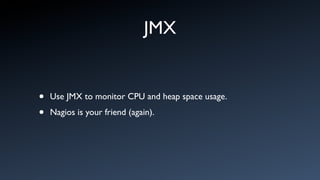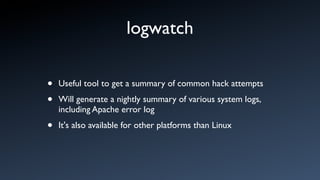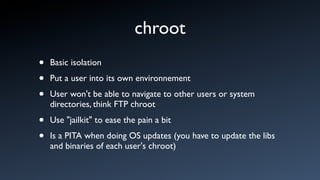Deployment of WebObjects applications on CentOS Linux
- 1. MONTREAL 1/3 JULY 2011 Deployment - post Xserve Pascal Robert Miguel Arroz David LeBer
- 2. The Menu • Deployment options • Deployment on CentOS Linux • Deployment on Ubuntu Linux • Deployment on BSD
- 4. Choices • Using your own hardware • Leasing the hardware • Virtual machines (VMWare ESXi/Xen) / VPS (Slicehost, Linode) • Cloud hosting (Amazon EC2/Windows Azure/RackSpace)
- 5. Your own hardware • Pros • It can be cheaper, if you use the hardware to its full potential. • You can resell it. • You do whatever you want. • Cons • You have to manage everything yourself. • Must get a good support contract in case of hardware problems • Not cost effective if you don't need a lot of processing power.
- 6. Leasing the hardware • Pros • The provider will take care of hardware problems, with resonable SLA. • You can buy software support, including backup solutions. • No big upfront cost, can pay per month. • Cons • Still have to manage the operating system yourself. • Less hardware and software support. • Can cost more in the long run.
- 7. Virtual machines/VPS • Pros: • You can isolate customers by using virtual machines. • Can create your own virtual environment on your own or leased hardware (Xen,VMWare ESX, KVM, etc.), or get VMs (VPS) on a hosted partner (Slicehost, Linode, etc.) • Easy to allocate more ressources to the VMs. • Snapshots! • Cons: • Can get pricy, especially for Virtual Private Server. • CPU is shared for all hosts on the physical server.
- 8. Cloud hosting (virtual machines on steroids) • Pros: • Tons of options. Example: load balancer, • Can be cheap if you don't need CPU or bandwith all of time. • Cons: • Can get very pricy if you use a lot of resources (bandwith, CPU, memory)
- 9. Price comparaison • One CPU, 2 GB of RAM, 64 GB disk space, 700 GB bandwith/ month • Leased hardware (iWeb.com): $99 (with 320 GB of storage) • VPS (Linode.com): $79.95 • Amazon EC2: $125.96 (1.7 GB of RAM)
- 10. Other things to check • 32 bits vs 64 bits • "Commercial software" • Adding volumes (LVM) • ... memory
- 11. Memory • If using a virtual machine, be it Amazon EC2, Xen or otherwise, check for memory usage of your app! • Amazon Linux don't have a swap partition! • On a 64 bits system, a single instance of an application can take up to 1.5 GB of memory! • A "micro" instance of Amazon Linux (32 bits) with Apache, wotaskd and JavaMonitor will eat up 187 MB of RAM.
- 12. Memory • Use the Xmx parameters to make sure your apps would not start using all "real" and "virtual" memory. • Monitoring the heap space of your instances to see if you need more memory. • For Amazon Linux: add a swap partition. • Use a 32 bits system if you only need a VM with less than 1.5 GB of RAM.
- 13. RedHat/CentOS/Amazon vs Ubuntu/Debian • RedHat Enterprise Linux is a "stable" release of work done in the Fedora project + support. • CentOS is the "free as in beer" clone of RedHat. • Amazon Linux is based on RedHat. • Debian is another distribution that is there for a long time. • Ubuntu is a deriative of Debian.
- 14. Which distro to use? • If you need to install commercial software, go with RedHat or CentOS. • CentOS is also more « stable » but packages can be very old (ex: PHP). • Ubuntu is the cool kid, and packages are more current. • Ubuntu Server LTS have support for 5 years. RedHat have support for 7 years. • CentOS major releases take more time to get out than RedHat.
- 16. Installing software on RedHat/ CentOS • Use the RPM package when possible. • rpm --install software.rpm • You can find other software on RPM Forge (http://rpmrepo.org/ RPMforge) • On CentOS, you can also use « yum » to get software from the CentOS and other repositories. • yum info sofware-name • yum install software-name
- 17. Starting/stopping services • Init scripts are in /etc/init.d • To start a service: • service serviceName start • To stop it: • service serviceName stop • To mark it to start at reboot: • chkconfig serviceName on
- 18. Network configuration • Network scripts are in /etc/sysconfig/network-scripts • If you do change, you have to restart the network script: • sh /etc/init.d/network restart • DNS resolver configuration file is /etc/resolv.conf (put your nameservers IP in there). • You can use the Network control panel too. • command line: system-config-network-tui • GUI (X11): system-config-network
- 19. GUI • By default, RedHat/CentOS will start in GUI mode, which will use some RAM. To disable the GUI when starting up, edit /etc/ inittab to put it in level 3 instead of 5. • Even if the GUI is not started, you can still start GUI apps remotely. • ssh -X user@host
- 20. User management • To create a user: • useradd -d /path/to/user/home -g main_group -G other_groups username • passwd username • To modify a user, use « usermod », to delete one, use « userdel ». • To change a password of another user: • passwd username (with no argument, it will change your own password) • GUI tool: system-config-users
- 21. Unneeded packages • Check that you are not running extra stuff that you don't need (sendmail, Samba, etc.) • You can get a list of started services with: • chkconfig --list | grep "on" • Check their description in the init.d script to see if you really need it.
- 22. Unneeded Apache modules • You should also disable unneeded Apache modules. Get the list of modules with: • httpd -M • You can delete unneeded module installed by RedHat/CentOS with Yum: • yum provides "mod_cgi.so" • yum erase mod_perl • Apache configuration files are in /etc/httpd/conf and /etc/httpd/ conf.d
- 23. Installing WO on RedHat/CentOS Linux
- 24. Installing a JVM • You can use OpenJDK 1.6 • yum install java-1.6.0-openjdk • ... but some other software (ex: Atlassian) doesn't work well with OpenJDK, so it's better to get the JVM from Oracle. • Oracle JVM install itself into /usr/java • To manage the JVMs, use « alternatives ». • alternatives --install /usr/bin/java java /usr/java/default/bin/java 2 • alternatives --config
- 25. Installing wotaskd and Monitor • Make sure you have Apache on the system. If not, you can install it with: • yum install httpd httpd-devel • Amazon Linux: beware, Apache is not installed by default • Follow the rest of the instructions from the wiki
- 27. top/free/vmstat • top: shows which processes are taking the most memory or CPU. Nice summary of load. • free: shows how much RAM and swap space is available. • vmtstat: good way to monitor RAM and I/O. • lsof: finding which resources are used by a process
- 28. JMX • Use JMX to monitor CPU and heap space usage. • Nagios is your friend (again).
- 29. Security
- 30. SSH • Configuration file on the server is /etc/ssh/sshd_config • Disable root login ("PermitRootLogin" directive) • Disable SSH v1 ("Protocol 2") • Allow only specific users • AllowUsers user1 user2 user3 • Run the server on a different port ("Port 2345") • Disable password authentification and use public/private keys. • PasswordAuthentication no
- 31. iptables • Software firewall included in RedHat/CentOS for a long time. • To list firewall rules: • /sbin/iptables --list • To save them in a text file: • /sbin/iptables-save > somefile.txt • To restore them from the text file: • /sbin/iptables-restore < somefile.txt
- 32. iptables • To block 1085 from the external network: • /sbin/iptables -A INPUT -i eth0 -p tcp -m tcp --dport 1085 -j DROP • /sbin/iptables -A INPUT -i eth0 -p udp -m udp --dport 1085 -j DROP
- 33. Protecting from brute force attacks • SSH password brute force attacks are common • ... and IMAP/POP3 brute force attacks are more and more popular too • If you can't disable SSH password authentification, use iptables to block IPs that are doing too much SSH requests for a given period
- 34. logwatch • Useful tool to get a summary of common hack attempts • Will generate a nightly summary of various system logs, including Apache error log • It's also available for other platforms than Linux
- 35. SSH tunnels • Don't allow access to JavaMonitor and your database servers from the outside world! Use SSH tunnels instead • SSH tunnel will map a local port with a remote server • Example, to access a remote PostgreSQL server and make it available on port 55432 on your system: • ssh -fNg -L 55432:127.0.0.1:5432 user@yourserver.com
- 36. SELinux • Policies-based security system • Apps are allowed to read/write only to specific paths • Can be a PITA to configure • Put SELinux in permissive mode first, check the warnings, fix them, put it on enforcing mode.
- 37. chroot • Basic isolation • Put a user into its own environnement • User won't be able to navigate to other users or system directories, think FTP chroot • Use "jailkit" to ease the pain a bit • Is a PITA when doing OS updates (you have to update the libs and binaries of each user's chroot)
- 38. OpenVZ • chroot on steroids • Think of Solaris Zones and BSD jails • Will run a copy of Linux userland for each "VZ" , including its own root user • Can only run Linux
- 39. Resources • http://wiki.centos.org/HowTos/Network/SecuringSSH • http://www.nsa.gov/ia/_files/os/redhat/rhel5-guide-i731.pdf • http://wiki.objectstyle.org/confluence/x/CYE5 • http://wiki.openvz.org/Main_Page • http://olivier.sessink.nl/jailkit/ • http://sourceforge.net/projects/logwatch/






































